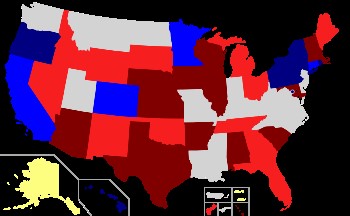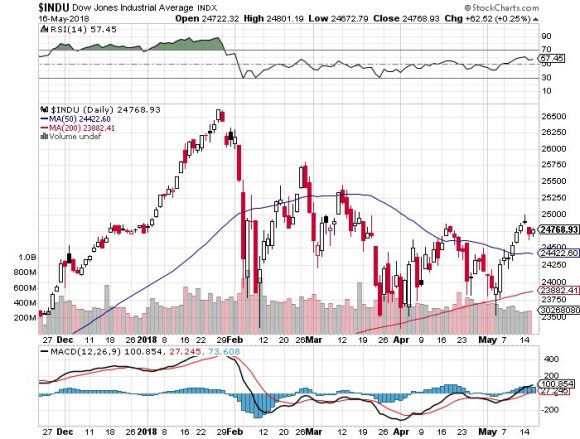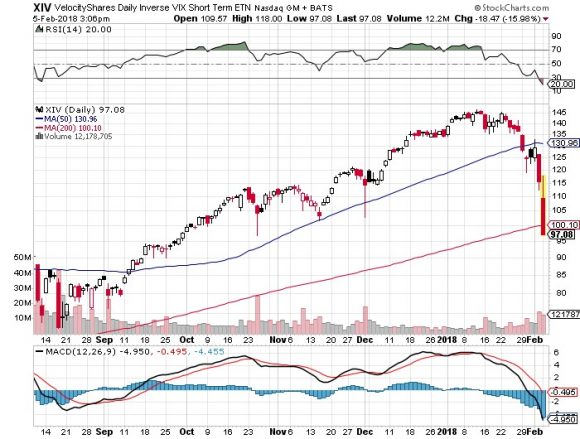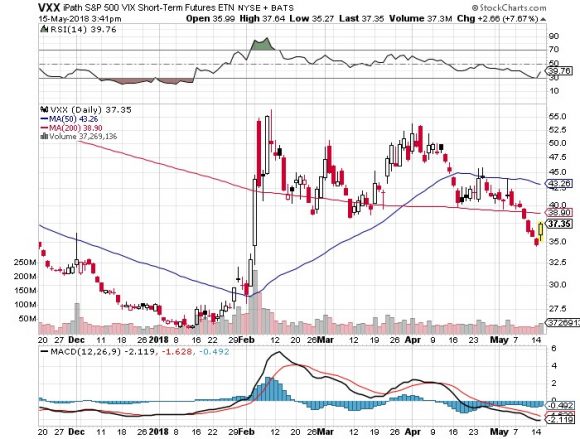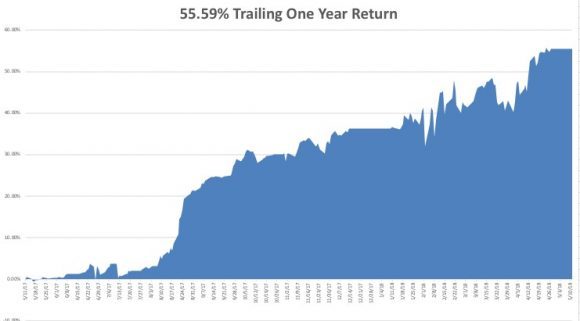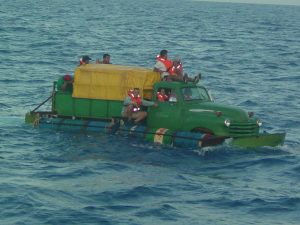Global Market Comments
May 17, 2018
Fiat Lux
Featured Trade:
(WHY THE "MIDTERM EFFECT" RULES THE MARKETS),
(WHO SAYS THERE AREN'T ANY GOOD JOBS?),
(TESTIMONIAL)
If I had a dime for every trading nostrum I have heard over the past 50 years I would be as rich as Croesus by now. And here's a whopper for you.
A 20% corporate growth rate, a 2% inflation rate, and a 0% stock market: These are numbers you never would expect to see in the same sentence.
Yet, that is what we have at the close today, believe it or not.
And what's worse, this condition could last for another five months. It is clear that something is going on here.
For the past six months, my trading has been wildly successful betting that the stock market would go nowhere until the November 6 midterm elections.
While we have covered an awful lot of ground during this time with a very wide 3,300-point range in the Dow Average (INDU), we have gone absolutely nowhere. As a result, the Mad Hedge Trade Alert Service stands with a 19.83% so far in 2018.
It turns out that trading around midterm congressional elections is far more successful than any other market traditions, like "Sell in May and go Away." Call it the Midterm Effect.
Since the Dow Average was first created on May 26, 1896, the six months going into a midterm produced a feeble 1.4% gain, while the six months after hauled in a whopping 21.8% increase.
In fact, "Sell in May and go away" only works because of the enormous cyclicality of the Midterm Effect, which takes place only every four years. The other three years of that cycle are usually pretty wishy-washy or go the opposite way. Here we are in mid-May, and so far, the Midterm Effect looks pretty good.
The effect only works for midterm elections. It is much less predictive than the Presidential Election Cycle, another popular piece of folk wisdom.
The reason the Midterm Effect works so well is because of human psychology. Investors absolutely hate uncertainty. They are much more inclined to sit on their hands and do nothing ahead of a major market moving event even one 10 months away, when we entered the current range.
They would much rather pay a premium after an event for any securities they might buy rather than being wrong. Money managers tend to be a conservative lot, and this is how conservatism works.
The outcome of the election would have an enormous effect on corporate earnings. According to PredictIt, an online betting site, there is a 67% chance that the Democrats will take the House in November.
If that occurs, no major changes to the economy nor laws pass for at least two years. If that doesn't occur, the president will have a free hand to pursue his existing policies unfettered. However, the election is not for another five months, and in politics that could be five lifetimes.
So range trading it is. Buy the small dips and sell the small rallies for the foreseeable future. Wake me up around Halloween.
Global Market Comments
May 16, 2018
Fiat Lux
Featured Trade:
(THE LAWSUITS ARE PILING UP ON THE XIV),
(XIV), (VXX),
(KISS THAT UNION JOB GOODBYE),
(TESTIMONIAL)
One of the most painful experiences of my half century long trading life involved the Credit Suisse VelocityShares Daily Inverse VIX Short-Term ETNs (XIV).
I was certain that the Volatility Index (VIX) would peak for the year at the Wednesday, February 5, 8:30 AM market opening. So, I shot out a Trade Alert to place only 10% of your capital into the (XIV), a bet that the (VIX) would fall. There was only a 15-minute window before the market closed during which readers could get in. A few managed to do it.
The (XIV) had just fallen from $147 to $95.00. We got in at $97.08, and it closed the day at $100. The (VIX) closed at $37. And we had made money many times selling short volatility over the past decade on spikes just like this one. The (XIV) had been the fastest growing of 3,500 ETFs over the past five years. So far, so good.
Then an hour after the close, I received an urgent call from a client. The (XIV) was trading at $14. What's up?
My initial instinct was that a major hedge fund had either gone bankrupt or had a margin call and was suffering a forced liquidation in the aftermarket.
Overnight, the (XIV) traded as low as $6.50. I later heard that Credit Suisse itself was the major buyer of volatility in the aftermarket, in fact was the ONLY buyer, and that it was deliberately attempting to bankrupt its own fund to limit its liability. Those in management in Zurich were afraid that if the (VIX) shot up to $100 it might take the entire bank down. In short, they panicked.
The next morning they issued notice that they were closing the fund in 10 days. I was certain that the managers were guilty of insider trading and securities fraud in ordering the emergency short cover, and that it was just a matter of time before the class action suits emerged.
Three months later, the lawsuit has been filed by the Gibbs Law Group in Oakland, CA, in the Southern District of New York for unspecified damages, expenses, and legal fees, with a jury trial demanded.
The last time I was involved with one of these was with the MF Global bankruptcy in 2011, where I and most of the rest of the trading community had an account.
I was initially offered 25 cents on the dollar. I refused, expecting to eventually get paid in full. I knew that the MF assets in question were never lost, they were just caught up in a conflict between U.S. and U.S. bankruptcy law that would eventually be resolved. That is what happened, and I was paid in full three years later.
The (XIV) case is much more complicated because there was a huge real loss, about $2 billion, and it involved complex mathematically constructed derivatives. Since the managers behaved so reprehensibly, and because the evidence of their misdeeds is so overwhelming, it is unlikely that the case will ever come to trial. Instead, there will be an out-of-court settlement.
If the SEC takes action it will further strengthen the plaintiffs' hands. There is currently an investigation of Credit Suisse underway and it ultimately could get banned from doing business in the United States.
My bet is that investors will get at least half their money back, if not more. But it could take years to get it, and in a class action the lawyers get a big chunk of any awards for their efforts, usually one-third. Sometimes, class actions can last as long as 10 years.
As for my own followers, most followed my advice to put no more than 10% of their capital into the trade. As it turned out, they made back the 9% loss in less than a month, half of it through selling volatility short again. But this time I used put spreads on the iPath S&P 500 VIX Short-Term Futures ETN (VXX), a long volatility play that will never go to zero overnight.
To read the suit in its entirety, please click here.
To learn more about the suit, please click here and here.
Or you can call the Gibbs Law Group directly at 510-350-9700. I'm sure they'd love to hear from you.
Trading Volatility Can Be Hazardous to Your Wealth
Global Market Comments
May 15, 2018
Fiat Lux
Featured Trade:
(FRIDAY, JUNE 15, 2018, DENVER, CO, GLOBAL STRATEGY LUNCHEON)
(GET READY FOR THE COMING GOLDEN AGE),
(SPY), (INDU), (FXE), (FXY), (UNG), (EEM), (USO),
(TLT), (NSANY), (TSLA)
I believe that the global economy is setting up for a new golden age reminiscent of the one the United States enjoyed during the 1950s, and which I still remember fondly.
This is not some pie in the sky prediction. It simply assumes a continuation of existing trends in demographics, technology, politics, and economics. The implications for your investment portfolio will be huge.
What I call "intergenerational arbitrage" will be the principal impetus. The main reason that we are now enduring two "lost decades" of economic growth is that 80 million baby boomers are retiring to be followed by only 65 million "Gen Xers."
When the majority of the population is in retirement mode, it means that there are fewer buyers of real estate, home appliances, and "RISK ON" assets such as equities, and more buyers of assisted living facilities, health care, and "RISK OFF" assets such as bonds.
The net result of this is slower economic growth, higher budget deficits, a weak currency, and registered investment advisors who have distilled their practices down to only municipal bond sales.
Fast forward six years when the reverse happens and the baby boomers are out of the economy, worried about whether their diapers get changed on time or if their favorite flavor of Ensure is in stock at the nursing home.
That is when you have 65 million Gen Xers being chased by 85 million of the "millennial" generation trying to buy their assets.
By then we will not have built new homes in appreciable numbers for 20 years and a severe scarcity of housing hits. Residential real estate prices will soar. Labor shortages will force wage hikes.
The middle-class standard of living will reverse a then 40-year decline. Annual GDP growth will return from the current subdued 2% rate to near the torrid 4% seen during the 1990s.
The stock market rockets in this scenario. Share prices may rise very gradually for the rest of the teens as long as tepid 2% growth persists. A 5% annual gain takes the Dow to 28,000 by 2019.
After that, after a brief dip, we could see the same fourfold return we saw during the Clinton administration, taking the Dow to 100,000 by 2030. If I'm wrong, it will hit 200,000 instead.
Emerging stock markets (EEM) with much higher growth rates do far better.
This is not just a demographic story. The next 20 years should bring a fundamental restructuring of our energy infrastructure as well.
The 100-year supply of natural gas (UNG) we have recently discovered through the new "fracking" technology will finally make it to end users, replacing coal (KOL) and oil (USO). Fracking applied to oilfields is also unlocking vast new supplies.
Since 1995, the United States Geological Survey estimate of recoverable reserves has ballooned from 150 million barrels to 8 billion. OPEC's share of global reserves is collapsing.
This is all happening while automobile efficiencies are rapidly improving and the use of public transportation soars.
Mileage for the average U.S. car has jumped from 23 to 24.7 miles per gallon in the past couple of years, and the administration is targeting 50 mpg by 2025. Total gasoline consumption is now at a five-year low.
Alternative energy technologies will also contribute in an important way in states such as California, accounting for 30% of total electric power generation by 2020, and 50% by 2030.
I now have an all-electric garage, with a Nissan Leaf (NSANY) for local errands and a Tesla Model S-1 (TSLA) for longer trips, allowing me to disappear from the gasoline market completely. Millions will follow. The net result of all of this is lower energy prices for everyone.
It will also flip the U.S. from a net importer to an exporter of energy, with hugely positive implications for America's balance of payments. Eliminating our largest import and adding an important export is very dollar bullish for the long term.
That sets up a multiyear short for the world's big energy consuming currencies, especially the Japanese yen (FXY) and the Euro (FXE). A strong greenback further reinforces the bull case for stocks.
Accelerating technology will bring another continuing positive. Of course, it's great to have new toys to play with on the weekends, send out Facebook photos to the family, and edit your own home videos.
But at the enterprise level this is enabling speedy improvements in productivity that are filtering down to every business in the U.S., lowering costs everywhere.
This is why corporate earnings have been outperforming the economy as a whole by a large margin.
Profit margins are at an all-time high. Living near booming Silicon Valley, I can tell you that there are thousands of new technologies and business models that you have never heard of under development.
When the winners emerge, they will have a big cross-leveraged effect on economy.
New health care breakthroughs will make serious disease a thing of the past, which are also being spearheaded in the San Francisco Bay area.
This is because the Golden State thumbed its nose at the federal government 10 years ago when the stem cell research ban was implemented. It raised $3 billion through a bond issue to fund its own research, even though it couldn't afford it.
I tell my kids they will never be afflicted by my maladies. When they get cancer in 20 years they will just go down to Wal-Mart and buy a bottle of cancer pills for $5, and it will be gone by Friday.
What is this worth to the global economy? Oh, about $2 trillion a year, or 4% of GDP. Who is overwhelmingly in the driver's seat on these innovations? The USA.
There is a political element to the new golden age as well. Gridlock in Washington can't last forever. Eventually, one side or another will prevail with a clear majority.
This will allow the government to push through needed long-term structural reforms, the solution of which everyone agrees on now, but for which nobody wants to be blamed.
That means raising the retirement age from 66 to 70 where it belongs and means-testing recipients. Billionaires don't need the maximum $30,156 annual supplement. Nor do I.
The ending of our foreign wars and the elimination of extravagant unneeded weapons systems cuts defense spending from $800 billion a year to $400 billion, or back to the 2000, pre-9/11 level. Guess what happens when we cut defense spending? So does everyone else.
I can tell you from personal experience that staying friendly with someone is far cheaper than blowing them up.
A Pax Americana would ensue.
That means China will have to defend its own oil supply, instead of relying on us to do it for them. That's why they have recently bought a second used aircraft carrier. The Middle East is now their headache.
The national debt then comes under control, and we don't end up like Greece.
The long-awaited Treasury bond (TLT) crash never happens. The Fed has already told us as much by indicating that the Federal Reserve will only raise interest rates at an infinitesimally slow rate of 25 basis points a quarter.
Sure, this is all very long-term, over-the-horizon stuff. You can expect the financial markets to start discounting a few years hence, even though the main drivers won't kick in for another decade.
But some individual industries and companies will start to discount this rosy scenario now.
Perhaps this is what the nonstop rally in stocks since 2009 has been trying to tell us.
Dow Average 1908-2018
Another American Golden Age is Coming
Global Market Comments
May 14, 2018
Fiat Lux
Featured Trade:
(THURSDAY, JUNE 14, 2018, NEW YORK, NY, GLOBAL STRATEGY LUNCHEON),
(THE MARKET OUTLOOK FOR THE WEEK AHEAD, OR TAKING ANOTHER BITE AT THE APPLE),
(AAPL),
(FAREWELL TO DAVID ROCKEFELLER)
What happens after markets test the top end of a range? They test the bottom end of the range. So, the game here is to pick where and when is the next short-term top.
Now that Q1 earnings are out of the way, there is no major positive driver of the market for two more months, until the end of July, when the Q2 earnings start to roll out. And they will be good.
That leaves us only geopolitical shocks and chaos from Washington as the major market influences, and none of those are going to be positive. When traders shift from a focus on earnings to fear, the result is usually negative for share prices.
One major event that occurred last week but was totally ignored by the media was the administration's trade negotiating team scampering back from China completely empty handed. They called his bluff. So, the trade war is still on, it's just moved from the front burner to the back burner. Don't get complacent.
And here is the worrisome issue for the bulls. Q1 earnings were up 25.5% YOY, one of the best in my long career. Revenues accounted for 8.3%, margin improvements 8.1%, new tax breaks 7.6%, and share buybacks 1.5%. This means that 35.6% of the total earnings were from one-time only benefits that aren't going to be there next year.
Given that the global economy is slowing down, revenue and margin improvement will probably drop by half next year. That means the best case for Q1 2019 earnings will show a drop from 25.5% to only 8.2%.
It's not a matter of IF the market will top out, but WHEN. Enjoy the bull move while it lasts. It isn't going to be there next year.
I decided to sit out the current leg up in the market. I didn't think it would be big or sustained enough to squeeze in another round trip. Besides, after shooting out 26 Trade Alerts in April earning an eye-popping 12.54% profit, not only was my staff exhausted, so were the followers.
My year-to-date return stands at a robust 19.30%, my trailing one-year returns have risen to 55.59%, and my eight-year sits at an 295.77% apex.
And remember, the market is making this move in the face of rising oil prices and interest rates, always bull market killers.
Of course, nobody at Apple (AAPL) cares about any of this one wit, as its stock blasted through to new all-time highs every day last week. Steve Jobs' creation is on a race to a $1 trillion market capitalization and was worth $930 billion at the market high. That's when Apple will have the same GDP as Russia or Australia.
The dividend yield has fallen to 1.56%. The company is increasingly being viewed as a luxury brand commanding a much higher multiple than the 9X that it earned when it was perceived as a lowly hardware company. By the way, Ferrari (RACE) has a price earnings multiple of 39X versus Apple's current 16X ex-cash.
I'll be raising my target for the stock from $200 to $220 as soon as I get time to write the report. Steve Jobs must be smiling down from Heaven. By the way, this service first recommended Apple as a strong "BUY" in 2010 when the shares traded at $10. That's a gain of 1,900%. Click here for the link.
Apple's stellar gains were part of a much broader move back into technology, which we expected. It turns out that the semiconductor cycle IS NOT ending after all, as predicted by the neophyte coverage of UBS.
Suddenly, all is forgiven at Facebook (FB), as the shares are now 2% short of an all-time high. Amazon is going from strength to strength, with Amazon Web Services' cloud business now accounting for an impressive $50 billion of sales and is growing at a breakneck 50% a year.
It all goes back to my seminal rule of investing that has worked for my entire 50-year career. While much of the rest of the U.S. economy is slowly fading from the scene, TECHNOLOGY ALWAYS COMES BACK!
The last of the Q1 earnings reports will dribble out this week.
On Monday, May 14, at 3:00 PM, we get a deluge of Feds speakers, now that the quiet period from the last meeting is over.
On Tuesday, May 15, at 8:30 AM EST, we receive the April Retail Sales, which has been red hot as of late. Home Depot (HD), a long-time Mad Hedge favorite, reports.
On Wednesday, May 16, at 8:30 AM, the April Housing Starts. Cisco Systems (CSCO) reports.
Thursday, May 17, leads with the Weekly Jobless Claims at 8:30 AM EST, which remained unchanged last week at 211,000, a 43-year low. At 10:00 AM EST, the April Index of Leading Economic Indicators is released, a compilation of 10 forward-looking statistics compiled by the private Conference Board. Applied Materials (AMAT) reports.
On Friday, May 18, we wrap up with the Baker Hughes Rig Count at 1:00 PM EST. Deere & Co. (DE) reports.
As for me, I'll be working in the garden this weekend. It's time to plant the pumpkins if I want nice jack-o-lanterns by Halloween, the tomatoes are thriving, and I will have an ample supply of fresh pepper this coming winter.
Good Luck and Good Trading.
Rolling in the Clover
Watching Sotheby's sell off the possessions of David Rockefeller, the memories came flooding back.
A Picasso went for a staggering $115 million, while a Monet fetched $80 million. A leather easy chair estimated at $300 sold for $8,000.
I've seen then all, either at the downtown headquarters of Chase Manhattan Bank, which Rockefeller turned into an art museum, or at dinner parties at his posh Upper East Side mansion.
I was sitting across the desk from Bob Baldwin, the chairman of Morgan Stanley. It was 1982, and I was 30 years old.
He carefully studied my resume in his hand. Then he picked up the phone and hit a button on speed dial to call David Rockefeller.
Rockefeller, the chairman of Chase Manhattan Bank, picked up.
Baldwin said, "I have a John Thomas sitting in front of me." He paused a second, and then hung up.
"He says you're alright," and Bob offered me a job on the spot to get the firm into the international equity business.
That's how I started a long and illustrious career at Morgan Stanley.
I eventually became one of the most successful traders in the company, and at one point accounted for 80% of equity division profits.
It is also where I learned the knowledge that I am passing on to you today through the Diary of a Mad Hedge Fund Trader and my trade mentoring service.
I have David Rockefeller to thank for getting me started.
So, it was with a heavy heart that I learned that he passed away recently at the ripe old age of 101.
Rockefeller was the youngest grandson of oil baron John D. Rockefeller, the founder of the Standard Oil Company. The modern-day spin-offs include ExxonMobil, Chevron, Amoco, and parts of British Petroleum.
The Sherman Antitrust Act was passed specifically to break up Rockefeller's oil refining monopoly.
Rockefeller was America's first billionaire.
Rockefeller could have had an easy life of moneyed leisure in high society.
He chose otherwise.
He grew up in a Manhattan 54th Street mansion attended by armies of nannies and servants, where his parents dressed black tie for dinner every night.
He remembers his doting grandfather, John D., who only gave him dimes "to keep us thrifty."
His mother founded the New York Museum of Modern Art in 1929, for which Rockefeller became chairman in later years.
He took the trouble to get a PhD in Economics from the University of Chicago in 1940, supporting Franklin Delano Roosevelt's deficit spending to end the Great Depression.
The family was horrified, as FDR's 90% maximum tax rate substantially whittled down the family's fortune by the time John Kennedy repealed it in 1962.
I got to know David Rockefeller well during the 1970s when I covered U.S. banking for The Economist magazine, and he spearheaded Chase Manhattan Bank's aggressive international expansion.
Rockefeller became the unofficial ambassador for the brash, unvarnished capitalism of the day. He wreaked establishment.
For a decade, whenever I interviewed major world leaders, such as Zhou Enlai of China, Ferdinand Marcos of the Philippines, Emperor Hirohito of Japan, or Margaret Thatcher of Great Britain, I would often bump into Rockefeller on the way out.
It was a bygone era, when major clients were courted primarily through the social register.
Eventually, international business came to account for 80% of Chase Manhattan's total profits.
It is perhaps fitting that Rockefeller was an early supporter of the construction of the original World Trade Center in downtown Manhattan, just walking distance from his bank.
I used to meet Rockefeller in his cavernous office on the 65th floor of the Chase Manhattan building near Wall Street. He sat behind a polished hardwood desk the size of Montana.
Also known for his immense art collection, almost every floor of the building was decorated with favorite pieces from his personal collection. There was even a Chagall on the way to the men's room.
In perhaps the greatest compliment every paid me, he told me he had 70,000 names in his Rolodex, and I was one of them.
Wow! To be in David Rockefeller's Rolodex! Did you get that mom?
Rockefeller was always charming and gracious to a T. He was the guy who was friendly to everyone, with a great sense of humor, even when he didn't have to be.
He was offered the post of U.S. Treasury Secretary by multiple administrations and turned them down every time. He preferred to spend more time on his prized collection of beetles instead, the largest in the world.
He worked well into his 90s and maintained an office on the 56th floor at Rockefeller Center, which his father had built to create jobs in New York during the Great Depression.
Because I was one of a handful of Morgan Stanley officers who spoke fluent Japanese, I was recruited to the team that sold Rockefeller Center to the Japanese for $1.3 billion in 1989. It was one of the largest real estate transactions in history at that time.
The last time I saw Rockefeller was at a gala black tie event for his 90th birthday at the Museum of Modern Art, where tables were selling for $90,000 a piece.
Rockefeller used the event to announce a staggering $100 million gift to the museum.
So, thank you David Rockefeller for all your help, and a life well lived.
They don't make them like you anymore.
You will be missed.
"It's easier to get out of Cuba than to get out of Facebook," said a market analyst.
Legal Disclaimer
There is a very high degree of risk involved in trading. Past results are not indicative of future returns. MadHedgeFundTrader.com and all individuals affiliated with this site assume no responsibilities for your trading and investment results. The indicators, strategies, columns, articles and all other features are for educational purposes only and should not be construed as investment advice. Information for futures trading observations are obtained from sources believed to be reliable, but we do not warrant its completeness or accuracy, or warrant any results from the use of the information. Your use of the trading observations is entirely at your own risk and it is your sole responsibility to evaluate the accuracy, completeness and usefulness of the information. You must assess the risk of any trade with your broker and make your own independent decisions regarding any securities mentioned herein. Affiliates of MadHedgeFundTrader.com may have a position or effect transactions in the securities described herein (or options thereon) and/or otherwise employ trading strategies that may be consistent or inconsistent with the provided strategies.


